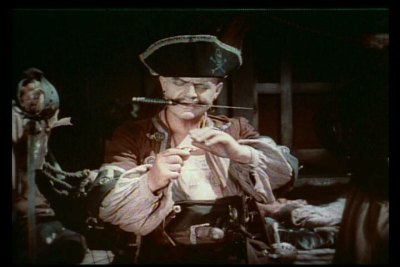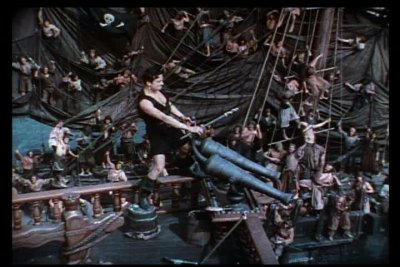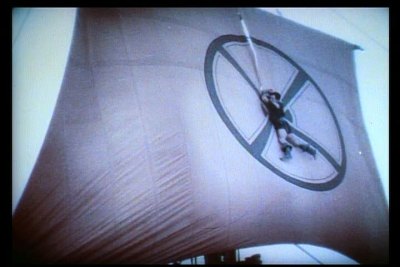| Reviews & Columns |
|
Reviews DVD TV on DVD Blu-ray 4K UHD International DVDs In Theaters Reviews by Studio Video Games Features Collector Series DVDs Easter Egg Database Interviews DVD Talk Radio Feature Articles Columns Anime Talk DVD Savant Horror DVDs The M.O.D. Squad Art House HD Talk Silent DVD
|
DVD Talk Forum |
|
|
| Resources |
|
DVD Price Search Customer Service #'s RCE Info Links |
|
Columns
|
|
|
Black Pirate, The
 This movie is part of the Douglas Fairbanks Collection boxed set released by Kino. You can read a review of the whole set here.
This movie is part of the Douglas Fairbanks Collection boxed set released by Kino. You can read a review of the whole set here.
This was Douglas Fairbanks last real hit. The films he did after this one did a respectable box office, but weren't smash hits like Mark of Zorro and Robin Hood.
Douglas Fairbanks was always trying to improve the look and feel of his movies. When he settled on a pirate sea adventure for his next film, Fairbanks decided that the movie needed to be in color.
This wasn't as strange as it may sound. Color films were not unheard of, even in the 1920's. Around the turn of the century, color was added to film by having it painted on. Women were hired to apply paints with very fine brushes onto the nitrate print film itself, one frame at a time. This, of course, was expensive and inexact. As film grew longer and the number of prints needed grew, the process become too expensive and time consuming. In 1906, Pathé patented a stencil process where the areas to be colored were cut out of one print, then placed over a second positive print. The pair were then dyed, allowing the bottom copy to retain the color. This process worked very well, but it was still time consuming and expensive. By the mid 1910's the process was all but abandoned.
There was also the Kinemacolor system that used a spinning wheel with red and blue green lenses in front of the camera and also the projector. The color was fairly accurate, but the imperfections in the process caused eye strain and headaches to the viewers, so the process never caught on.
For this sea epic, Fairbanks settled on a color system invented by a small company named Technicolor. Their system used a modified Bell and Howell camera. There was a prism inside that split the image, and then sent the light through two different color filters and exposed two negatives. From this, two color positives were made that were cemented together. When projected, a color film appeared.
There were limitations to this system. Due to the absorption of light by both the prism and filters, a large amount of light was needed on the subjects. It took much longer for the film to be developed and cemented, and certain colors did not show up well. Even given these problems, Fairbanks thought the film would be better in color than in black and white. He was right.
 Fairbanks plays man, Michael, who is unlucky to be traveling on a ship that is captured by pirates. After looting the ship, the brigands tie the crew to the mast and blow the ship up. Michael and his father survive, and manage to swim to an island, but the exertion is too much for the older man, and he dies soon after reaching safety. Fairbanks vows on his father's grave to bring the men who caused his death to justice.
Fairbanks plays man, Michael, who is unlucky to be traveling on a ship that is captured by pirates. After looting the ship, the brigands tie the crew to the mast and blow the ship up. Michael and his father survive, and manage to swim to an island, but the exertion is too much for the older man, and he dies soon after reaching safety. Fairbanks vows on his father's grave to bring the men who caused his death to justice.
As luck would have it, the pirates land on the same island to hide their treasure. Michael appears and states that he'd like to join their crew. When they laugh at him, he challenges the captain to a fight, and wins handily. The first officer (Sam De Grasse) is still not convinced, so Michael offers to capture the next ship that they sight single-handedly, without firing a shot.
At dawn the next morning, they spot a ship laden with cargo. In the most exciting scene in the movie, true to his word, Michael captures the ship all by himself. During the action Michael ends up high in the rigging, and, in a stunt that will become a standard in most pirate movies after this one, he pulls out his knife and jumps into the sail, slicing it as he descends to break his fall.
Because of his daring and bravado, the pirate crew decide that he should lead them. He accepts and declares that from now on, he will be known as the Black Pirate!
Meanwhile the crew find a young princess on the recently captured ship (Billie Dove.) As the crew draws straws for her, Michael interrupts them. Instead of blowing the ship up, they will ransom it. And to ensure the ransom is paid, they will hold the princess hostage. The first officer doesn't like the idea, he wants the girl for himself. Michael, of course, is planning on helping the girl escape. But when the Black Pirate is caught helping their hostage escape, the crew turns on him, and makes him walk the plank. How can he possibly save himself, the princess, and avenge his father?
 This swashbuckling drama was exciting, even though it has some flaws. After the Fairbanks captures the cargo ship, the action tapers off quite a bit, not really picking up again until the last reel or two.
This swashbuckling drama was exciting, even though it has some flaws. After the Fairbanks captures the cargo ship, the action tapers off quite a bit, not really picking up again until the last reel or two.
Douglas Fairbanks puts on another great performance, but Billie Dove, who was hired since her complexion photographed well in Technicolor, spends much of the movie just looking scared or bored. Sam De Grasse, who played Prince John in Robin Hood, does a wonderful job as Fairbanks' nemesis.
The big star of this film though is the color. It feels very strange at first to be watching a color silent film. While the Technicolor process used for this film was not nearly as successful as the three strip version that they would invent in later years, it does add a unique character to the film.
After the film was released, there were a lot of problems with the Technicolor prints. The film would cup and bow at random places in the reels, causing the film to skip and jump. There were other problems with projection too. It was hard to get the right amount of light to go through the film. At the level a black and white films was shown, the colors were too dark, but higher light levels risked melting the film. Due to the problems he had filming and problems with the prints afterwards, Fairbanks abandoned the color process.
The DVD:
Audio:
The soundtrack consists of the original 1926 score being preformed by a small orchestra under the direction of Robert Isreal. The score is very good, and adds a good deal to the viewing experience. The sound quality is also very nice, though I could have used a little more bass response.
Video:
The restored two strip Technicolor print is astounding to watch. It is not bright and bold like the later Technicolor films, but the colors are fairly accurate. Though there are several problems with the color, most of them are probably inherent in the filming process rather than a defect in the print, but I'll list them here for convenience's sake. The colors have a slightly washed out look to them, probably because of the large amounts of light needed for the process to work. The whole picture has an odd tone to it, as if the picture had been colorized. I chalk it up to the fact that the two strip process could not pick up yellow. Some of the darker scenes have odd shadow in patches of black, it almost looks like emulsion damage, but it can't be attributed to that. Even with these defects, the colors do look nice. You will be surprised the first time you see it.
Aside from those quibbles, the DVD looks very nice. There are hardly any scratches and dirt on the print, something us silent movie fans have had to live with up till now. The detail in the picture is excellent. You can clearly make out the grain in the letters of the father's tombstone and the insignia on Fairbanks' ring. The lines are very clear, especially for a film this old. Overall an excellent DVD.
The Extras:
There are a couple of interesting bonus features on this disc. First off is a commentary by film historian Rudy Behlmer. This was originally recorded for the LD release of this movie. I was looking forward to this, but was slightly disappointed. His delivery was very wooden, as if he was reading from a script. The information he gave was not scene specific either. He talked a lot about how many people were effected and admired this movie, and read a lot of quotes from them. The information content picked up as he went along though. Later he talks about the actors and what they went on to do. Overall, it was an interesting commentary, and it adds a lot to the DVD, but not as much as I was hoping.
There is also a 19 minute reel of outtakes narrated by Rudy Behlmer. It was really interesting to see some of what went on behind the camera and what wasn't used. A great addition to the disc.
Final Thoughts:
The Black Pirate is a very entertaining film. It has some classic stunts, and great action scenes. By some estimates, over 95% of the silent movies that were made in color are lost. This rare chance to see a feature with a restored two strip Technicolor process image makes this DVD a no-brainer. Highly recommended.
|
| Popular Reviews |
| Sponsored Links |
|
|
| Sponsored Links |
|
|
| Release List | Reviews | Shop | Newsletter | Forum | DVD Giveaways | Blu-Ray | Advertise |
|
Copyright 2024 DVDTalk.com All Rights Reserved. Legal Info, Privacy Policy, Terms of Use,
Manage Preferences,
Your Privacy Choices | |||||||













